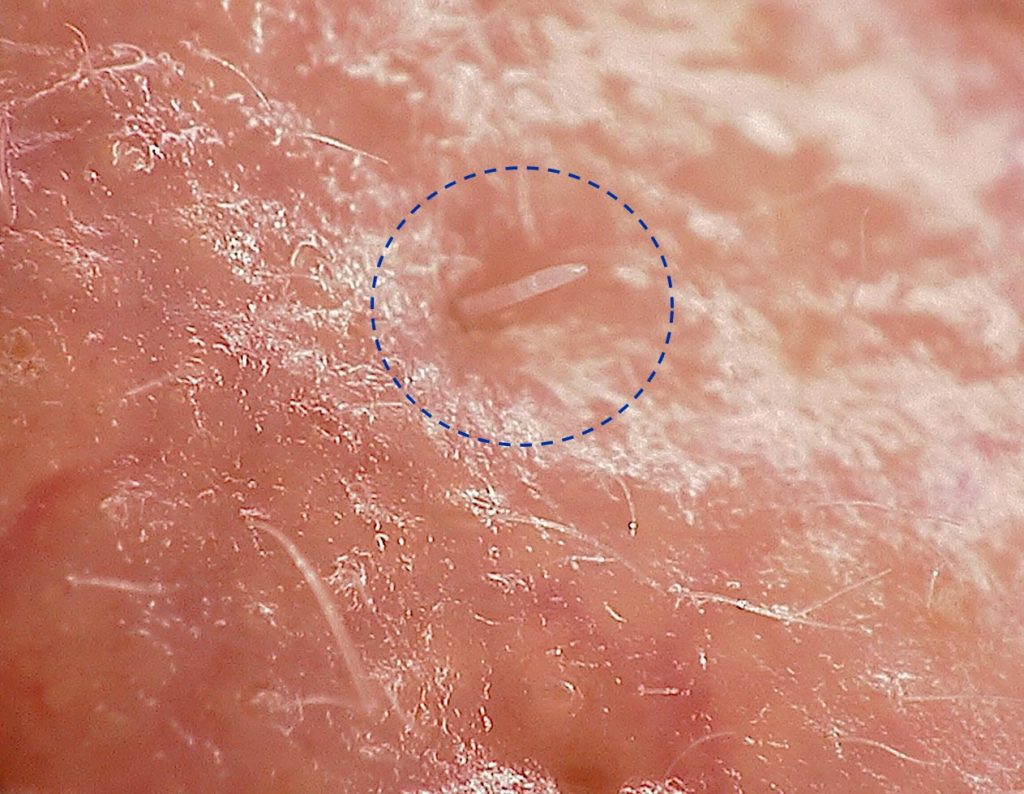

The photo shows Demodex folliculorum mites on the skin under a Hirox microscope. Credit: University of Reading
The secret of the life of mites in the skin of our faces.
First ever full[{” attribute=””>DNA analysis of mites that live in the hair follicles of all humans reveals explanations for their bizarre mating habits, body features and evolutionary future.
Microscopic mites that live in human pores and mate on our faces at night are becoming such simplified organisms due to their unusual lifestyles that they may soon become one with humans, new research has found.

Image shows the unusually-positioned penis of a Demodex folliculorum mite. Credit: University of Reading
The mites are passed on during birth and are carried by almost every human, with numbers peaking in adults as the pores grow bigger. They measure around 0.3mm long, are found in the hair follicles on the face and nipples, including the eyelashes, and eat the sebum naturally released by cells in the pores. They become active at night and move between follicles looking to mate.
The first ever genome sequencing study of the D. folliculorum mite found that their isolated existence and resulting inbreeding is causing them to shed unnecessary genes and cells and move towards a transition from external parasites to internal symbionts.

Microscope image of the posterior end of the anus of a Demodex folliculorum mite. The presence of an anus on this mite had been wrongly overlooked by some previously, but this study confirmed its presence. Credit: University of Reading
Dr. Alejandra Perotti, Associate Professor in Invertebrate Biology at the University of Reading, who co-led the research, said: “We found these mites have a different arrangement of body part genes to other similar species due to them adapting to a sheltered life inside pores. These changes to their DNA have resulted in some unusual body features and behaviors.”
The in-depth study of the Demodex folliculorum DNA revealed:
- Due to their isolated existence, with no exposure to external threats, no competition to infest hosts, and no encounters with other mites with different genes, genetic reduction has caused them to become extremely simple organisms with tiny legs powered by just 3 single cell muscles. They survive with the minimum repertoire of proteins – the lowest number ever seen in this and related species.
- This gene reduction is the reason for their nocturnal behavior too. The mites lack UV protection and have lost the gene that causes animals to be awakened by daylight. They have also been left unable to produce melatonin – a compound that makes small invertebrates active at night – however, they are able to fuel their all-night mating sessions using the melatonin secreted by human skin at dusk.
- Their unique gene arrangement also results in the mites’ unusual mating habits. Their reproductive organs have moved anteriorly, and males have a penis that protrudes upwards from the front of their body meaning they have to position themselves underneath the female when mating, and copulate as they both cling onto the human hair.
- One of their genes has inverted, giving them a particular arrangement of mouth appendages extra protruding for gathering food. This aids their survival at a young age.
- The mites have many more cells at a young age compared to their adult stage. This counters the previous assumption that parasitic animals reduce their cell numbers early in development. The researchers argue this is the first step toward the mites becoming symbionts.
- The lack of exposure to potential mates that could add new genes to their offspring may have set the mites on course for an evolutionary dead end, and potential extinction. This has been observed in bacteria living inside cells before, but never in an animal.
- Some researchers had assumed the mites do not have an anus and therefore must accumulate all their feces through their lifetimes before releasing it when they die, causing skin inflammation. The new study, however, confirmed they do have anuses and so have been unfairly blamed for many skin conditions.
Demodex follicular mite under the microscope walks. Credit: University of Reading
The research was led by Bangor University and the University of Reading, in collaboration with the University of Valencia, the University of Vienna and San Juan National University. It was published in the magazine Molecular biology and evolution.
Dr Henk Braig, co-lead author from Bangor University and the National University of San Juan, said: “Moths have been blamed for a lot of things. Their long association with humans may suggest that they could also have simple but important beneficial roles, for example , in keeping the pores of our face disconnected.”
Reference: “Human follicular mites: ectoparasites become symbionts” by Gilbert Smith, Alejandro Manzano Marin, Mariana Reyes Prieto, Katia Sofia Ribeiro Antunes, Victoria Ashworth, Obed Nangul Gussel, Abdelhalim Abdelsamad A. Jan, Andrés Moya and Amparo Latori, Mother. Alejandra Perotti and Henk R. Bragg, 21 June 2022, Available here. Molecular biology and evolution.
DOI: 10.1093/molbev/msac125

“Web maven. Infuriatingly humble beer geek. Bacon fanatic. Typical creator. Music expert.”





More Stories
Scientists confirm that monkeys do not have time to write Shakespeare: ScienceAlert
SpaceX launches 23 Starlink satellites from Florida (video and photos)
A new 3D map reveals strange, glowing filaments surrounding the supernova